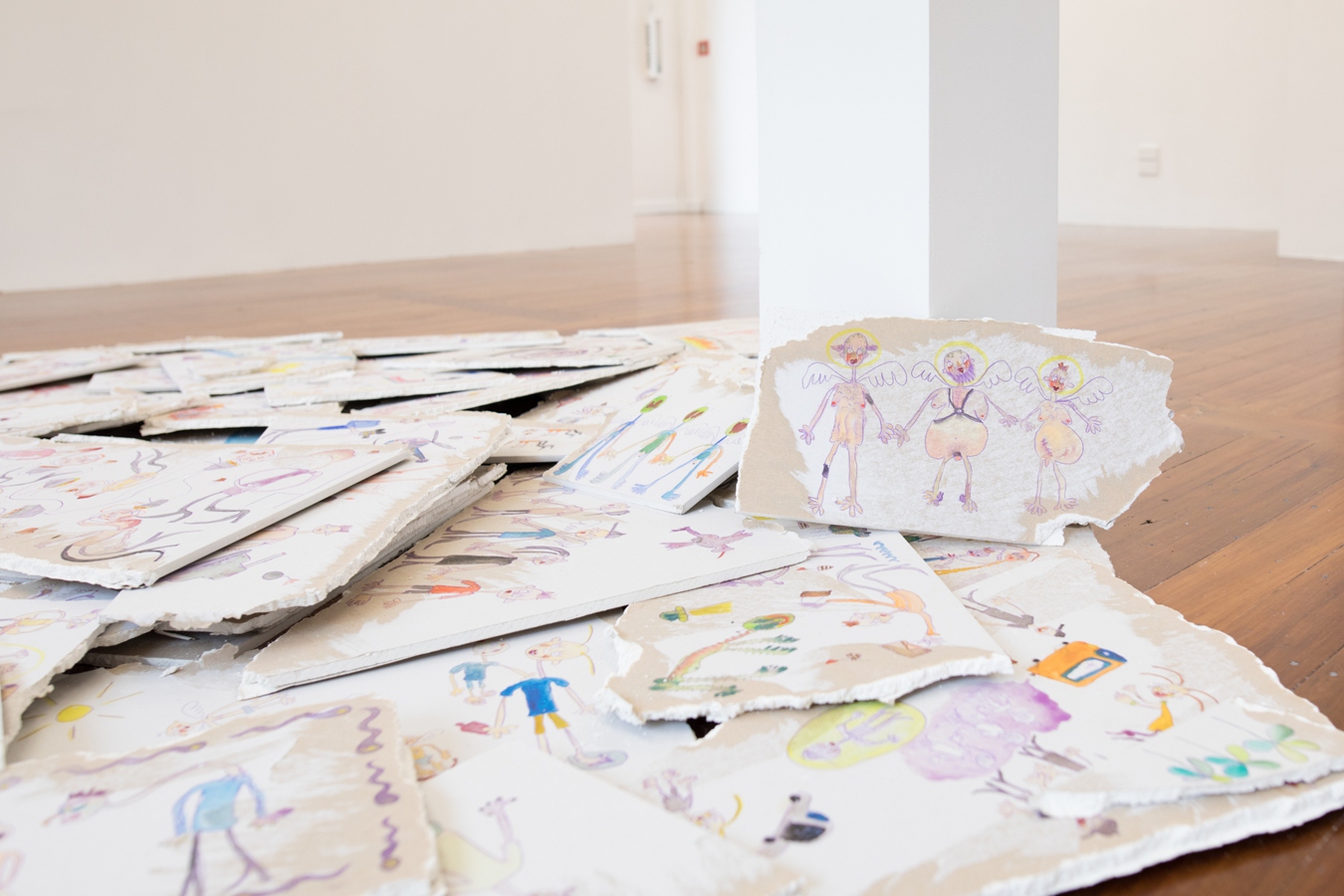Priscilla Rose Howe and Daniel John Corbett Sanders
Backdirt
09 Mar — 21 Apr 2023
Backdirt
Priscilla Rose Howe and Daniel John Corbett Sanders
Curated by Abby Cunnane
Exhibition runs: 10 March - 21 April 2023
Whakatau and opening: Thursday 9 March, from 5:30pm
Back dirt is the dirt that is put to one side in the process of an archeological dig. It might be refiltered later for fragments, or simply returned to fill the hole. Another reading is in relation to the human body, and residual matter that it may accumulate out of sight: gunge, gunk, dreg. The exhibition title draws on both these sets of associations, proposing we look again at that which is often put aside, or less visible in mainstream representations of queerness. Figurative works by Priscilla Rose Howe and Daniel John Corbett Sanders register a spectrum of states: joy, excess, discomfort, pain, sadness and anger. In doing so they set out to expand the room for public expressions of queerness, beyond what is marketable and tidy, into a space of powerful, ordinary, multiplicity.
On the back wall of the gallery, Howe’s drawing of an imagined queer future scenario emanates an atmosphere of euphoria. People sit in a sauna, shared with live eels, dead oysters, a fish on a plate, glowing prawns. Queer filmmaker John Waters’ work, and drag culture’s influence more generally, is evident in the made-up faces, elastic eyebrows, and pastel contouring tenderly undertaken by the artist. There is perhaps a nod to bathhouses famous in queer history, such as the Continental Baths in The Ansonia Hotel basement, Manhattan, opened in the late 1960s. However, rather than stemming from a documentary impulse, this is a dreamed-of queer future where pleasure and possibility is foregrounded. The group are at ease in public space, eating, drinking and talking, at ease in their bodies and in the world they inhabit alongside other creatures. The food plays a role too: these are hungry, desire-filled, consuming humans rather than abstract symbols of queerness. They eat, overeat and stay in the pool too long; they get sunburnt and tired.
Loosely piled plasterboard shards with watercolour paintings on them, Sanders’ works document the artist’s personal history, including family anecdotes, memories from childhood, and dreams. In contrast to the tone of Howe’s work, these scenes are sometimes grisly or surreal, recalling experiences of growing up in a conservative and colonised 90s New Zealand where heterosexuality is the enforced norm, and queer sexuality may be considered a form of aberrance. Sanders’ works include imagery of the artist’s birth, of queer sex and fetish, of a series of surgeries he has had, of his brother losing his teeth while whitebait fishing, of many bodies that don’t match with a mass-produced homoerotic ideal, and of his keen golfer grandmother. This work exists as a personal archive, within which experiences of trauma, shame, and disorientation are acknowledged, inseparable from and alongside of humour, dignity and self-recognition.
Sanders’ process is cumulative, and this work was built up over an extended period of drawing and painting sessions, alongside ongoing wider contextual research into sites and events in Aotearoa’s queer history. This includes looking back to a time when it was illegal to be gay in Aotearoa, one inheritance of the British colonial justice system. Strong organised movements for equality became increasingly visible here in the 1970s, led by people including lesbian and Māori rights activist Ngahuia Te Awekotuku. The Homosexual Law Reform Bill ultimately passed in Parliament by five votes in July 1986. Today, Gay Pride is nationally observed across the month of March. Considered alongside these large-scale social and legal shifts towards equality, Sanders’ work persists, like salt in a wound, to resist an easy narrative of ‘progress’. Rather, this sprawling pile of works suggest that the social recognition of queer identity is always-in-process, always contested, and sometimes absurd.
These works by Sanders and Howe lean in to highly personal experiences, and aesthetics. At the same time, there is a broad underlying resistance to the ways that contemporary queer identities may be co-opted by neoliberal interests: to sell products and as proof of progressive thinking, or used as a distraction or ‘pinkwashing’. That is, a narrow and often white-biassed definition of gay rights may be used to cover other types of discrimination and harm. In opposition to this, Howe and Sanders’ imagery asserts the place of multiplicity, dreaming, self-identity and complex relationships within a public queer imaginary. These works refuse the idea that identities are singular. Rather, they inhabit a queer world that is abundant, untameable, and infinitely various.
--
Priscilla Rose Howe is an artist based in Ōtautahi. Predominantly using drawing materials, Howe explores ideas around queerness, phenomenology and the supernatural within domestic and public settings. Her works suggest a space that is at once magical and worldly, grotesque, and desire-filled. Recent exhibitions include Banquet, The Art Paper, 31 Lorne St, Tāmaki Makaurau, (2023); Green Lipped; Jhana Millers Gallery, Te Whanganui-a-Tara (2022); The Person (with Alex Laurie and Tom Tuke), Coastal Signs, Tāmaki Makaurau (2022); Cruel Optimism: New artists show, Artspace Aotearoa, Tāmaki Makaurau (2021); and In a pool of mud, the night was hot, Sanc Gallery, Tāmaki Makaurau (2021).
Daniel John Corbett Sanders is a Pākehā artist and curator based in Te Whanganui-a-Tara. He is interested in critical geographies and social power structures, especially the relationship between LGBTQIA+ people and political economies. His work is fantastical, and often references film techniques by playing with storyboarding, vignettes, and narrative. Recent exhibitions include Becoming Animals, Play_Station, Te Whanganui-a-Tara (2022); Broken Sovereignty, Lightship, Tāmaki Makaurau (2022); Wild Once More, Te Tuhi, Tāmaki Makaurau (2022); and Urban Nothing, RM Gallery and Project Space, Tāmaki Makaurau (2021).



















